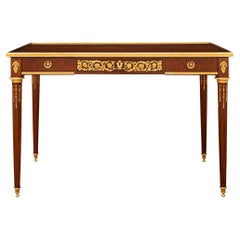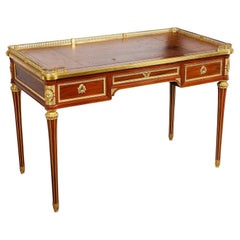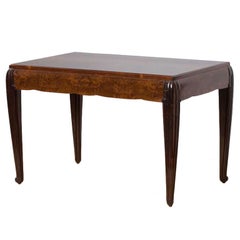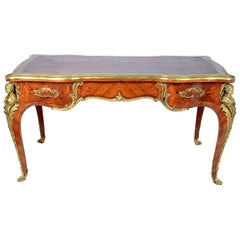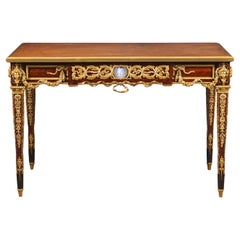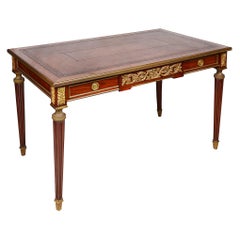Mahogany Desks and Writing Tables
to
92
Height
to
Width
to
Depth
to
452
328
783
19
3
95
72
65
56
55
33
31
26
16
16
5
4
3
1
1
82
430
271
22
90
112
25
19
10
14
23
12
32
18
7
7
2
20,796
6,279
3,082
1,465
1,155
622
316
266
203
85
805
789
790
10
7
5
4
4
Material: Mahogany
French 19th century Louis XVI st. Mahogany, Kingwood and Ormolu table/desk
Located in West Palm Beach, FL
An elegant and high quality French 19th century Louis XVI st. Mahogany, Kingwood and Ormolu center table/desk, attributed to Francois Linke. This truly stunning rectangular table/des...
Category
19th Century French Louis XVI Antique Mahogany Desks and Writing Tables
Materials
Ormolu
19th Century French Mahogany Bureau Plat, After Henry Dasson
By Henry Dasson
Located in Brighton, Sussex
A fine quality late 19th century French Mahogany Bureau plat, after Henry Dasson, having an inset leather top with a three quarter ormolu gallery, three Mahogany line freize drawers,...
Category
19th Century French Louis XVI Antique Mahogany Desks and Writing Tables
Materials
Mahogany
Pierre-Paul Montagnac, Art Deco Table, France, 1926
Located in New York, NY
Art Deco console table by Pierre-Paul Montagnac (1883-1961)
Signed on underside: Montagnac, 1926
Bibliography: Le Mobilier du XXe Siecle, Dictionnaire des créateurs by Pierre K...
Category
20th Century French Art Deco Mahogany Desks and Writing Tables
Materials
Mahogany, Walnut
Frederic Schmit, Paris, Large Louis XVI Style Bureau Plat, 19th Century
Located in Brighton, Sussex
A fine quality 19th century marquetry inlaid French Louis XVI style bureau plat. Having an inset tooled leather top, an ormolu moulding around, three oak lined frieze drawers, with the locks stamped; Schmit, Paris. Dummy drawers to the reverse.
The frieze being bombe shaped all the way round, quartered veneers and marquetry inlay. Wonderful ormolu monopodia supports to the tops of the elegant cabriole legs that terminate in hairy paw feet.
Frédéric Schmit...
Category
19th Century French Louis XVI Antique Mahogany Desks and Writing Tables
Materials
Kingwood, Mahogany
$41,547 Sale Price
20% Off
A Louis XVI Style Parquetry Inlaid Writing Table By Emmanuel Zwiener
Located in Brighton, West Sussex
A Louis XVI Style Gilt-Bronze Mounted Bois Satiné Parquetry Inlaid Writing Table, By Emmanuel Zwiener, Paris.
The top of gilt-tooled tan leather surrounded by a stiff-leaf cast edge...
Category
19th Century French Louis XVI Antique Mahogany Desks and Writing Tables
Materials
Bronze
Louis XVI Style Mahogany Writing Table, circa 1890
Located in Brighton, Sussex
A very good quality 19th century French Louis XVI style mahogany bureau plat. Having an inset leather top, gilded ormolu mouldings and scrolling foliate mounts to the frieze, two fri...
Category
Late 19th Century French Louis XVI Antique Mahogany Desks and Writing Tables
Materials
Ormolu
Charles X desk in mahogany feather with two drawers, mid-19th century
Located in Catania, IT
Charles X mid-1800s mahogany feather banded writing desk with inlays
and two drawers and with arched legs joined by crossbar with 4 wheels.
The desk measures:
Length when closed c...
Category
Mid-19th Century English Charles X Antique Mahogany Desks and Writing Tables
Materials
Mahogany
$2,390 Sale Price
20% Off
A George IV mahogany mechanical escritoire attributed to Gillows
Located in Lymington, Hampshire
A George IV mahogany mechanical escritoire attributed to Gillows, of rectangular form with a vertical superstructure on reeded cabriole legs with a turned stretcher and the original ...
Category
1820s English George IV Antique Mahogany Desks and Writing Tables
Materials
Brass
Fine Quality Louis XVI Style Bureau Plat, 19th Century
Located in Brighton, Sussex
A very good quality 19th century Louis XVI style mahogany bureau plat. Having an inset leather top, wonderful gilded ormolu mounts, the single frieze drawer having a drop front, open...
Category
19th Century French Louis XVI Antique Mahogany Desks and Writing Tables
Materials
Ormolu
$30,614 Sale Price
20% Off
French 19th Century Louis XVI Style Mahogany Desk ‘A la Tronchin’
Located in West Palm Beach, FL
An attractive and unusual French 19th century Louis XVI st. mahogany desk 'A la Tronchin'. The desk is raised by square tapering legs with original ormolu sabots and castors. The str...
Category
19th Century French Louis XVI Antique Mahogany Desks and Writing Tables
Materials
Mahogany
Regency Period Brass Inlaid Side Table, Attributed to John Maclean, circa 1820
By John Mclean
Located in Brighton, Sussex
A fine quality English Regency period brass inlaid side table, with a hinged reading / writing slope, compartments opening to the sides for writing and drawing implements, a pleated box...
Category
19th Century English Regency Antique Mahogany Desks and Writing Tables
Materials
Brass
Rare Antique English Mahogany Brass Bound Travel Box, circa 1800
Located in New Orleans, LA
Rare antique english mahogany brass bound travel box, circa 1800.
Category
Early 19th Century English Antique Mahogany Desks and Writing Tables
Materials
Brass
George III Period Mahogany Fitted Desk Attributed to Gillows of Lancaster
Located in Lincolnshire, GB
An 18th century mahogany desk or sometimes called architects desk, with fitted top drawer containing a baize lined wiring surface below which is a fitted section contains alphabet inlaid letter boxes The double top drawer slides out on hidden rollers and the baize section then slides back.
Original swan neck brass handles and fine flame mahogany. finished with dummy drawers to the back making this a free standing desk.
A model is in the Gillow design...
Category
18th Century English Antique Mahogany Desks and Writing Tables
Materials
Brass
French 19th Century Louis XVI Style Belle Époque Period Desk
By Henry Dasson
Located in West Palm Beach, FL
A stunning and extremely high quality French 19th century Louis XVI st. Belle Époque period mahogany, ormolu and leather desk, signed Henry Dasson 1877. The desk is raised by elegant...
Category
19th Century French Belle Époque Antique Mahogany Desks and Writing Tables
Materials
Ormolu
Desk in Mahogany by Ole Wanscher '1903 - 1985'
Located in Aalsgaarde, DK
Freestanding desk in mahogany by Ole Wanscher (1903 - 1985) with original hardware. Made at A.J. Iversen in 1960’s
H. 76 H-apron. 64 W. 149 D. 78 cm
H. 29.9 H-apron. 25.1 W. 58.6 ...
Category
20th Century Mahogany Desks and Writing Tables
Materials
Mahogany
French 19th Century Kidney Shaped Mahogany Writing Table
Located in West Palm Beach, FL
An exceptional and large-scale French 19th century kidney-shaped mahogany writing table with one drawer. The table is raised on a scrolled lyre-shaped supports joined by a geometric ...
Category
19th Century French Antique Mahogany Desks and Writing Tables
Materials
Ormolu
19th Century Sheraton Revival Inlaid Desk
Located in Brighton, Sussex
A very good quality 19th Century Edwardian period, Sheraton Revival inlaid desk. Having a fire screen that pulls up, secret compartments that pop out from the sides for ink and pens....
Category
Late 19th Century English Sheraton Antique Mahogany Desks and Writing Tables
Materials
Mahogany
Regency-Style Mahogany Leather-Topped Table
Located in New Orleans, LA
Crafted of rich mahogany, this library table displays all of the sophistication Regency-era furnishings are known for. This table features a straightforward design with beautifully c...
Category
19th Century English Regency Antique Mahogany Desks and Writing Tables
Materials
Brass
19th Century Miles and Edwards Writing Table
Located in Dublin 8, IE
19th century Miles and Edwards writing table of unusual shaped top, with leather scribe on barley twist leg.
Category
19th Century Irish Antique Mahogany Desks and Writing Tables
Materials
Mahogany
French 19th Century Louis XVI St. Mahogany Side Table/Desk
Located in West Palm Beach, FL
A lovely French 19th century Louis XVI st. Mahogany side table/desk. The kidney shaped Table à Écrire is raised by elegantly curved supports connected with a fine stretcher below the...
Category
19th Century French Louis XVI Antique Mahogany Desks and Writing Tables
Materials
Mahogany
19th Century Marquetry Writing Table in the manner of Holland & Sons
Located in London, GB
A good writing table in the Manner of Holland & Sons
Constructed in mahogany, with specimen wood inlays, and gilt bronze mounts; of rectangular form, with bowed ends, rising from ri...
Category
19th Century British Victorian Antique Mahogany Desks and Writing Tables
Materials
Ormolu, Bronze
Lucien Rollin, Secretaire, circa 1935
Located in West Palm Beach, FL
Lucien Rollin, Secretaire,
circa 1935.
Mahogany and silvered bronze,
Meaures: 60.25 in. (153.03 cm.) x 50 in. (127 cm.) x 15.12 in. (38.41 cm.).
Category
1930s Vintage Mahogany Desks and Writing Tables
Materials
Mahogany
A large mahogany reading stand by Yabsley of Plymouth
Located in Lymington, Hampshire
A large mahogany reading stand by Yabsley of Plymouth, the octagonal support set on a cruciform base with scroll feet and bold scrolling brackets, surmounted by an adjustable rectang...
Category
1860s European Antique Mahogany Desks and Writing Tables
Materials
Wood, Mahogany
Leather Topped Regency Rectangular Mahogany Pedestal Table
Located in Shrewsbury, GB
Stylish Regency mahogany centre/ breakfast table in the neo-classical manner. the mahogany is fabulous quality and the top is laid well figured green leather top, with rounded corner...
Category
Early 19th Century Regency Antique Mahogany Desks and Writing Tables
Materials
Leather, Mahogany
George III Carlton House Desk Mahogany United Kingdom XIX Century
Located in Milano, IT
English desk supported by truncated pyramidal legs with brass feet, has three drawers in the band; the top in the center has a Moroccan insert that can be lifted like a lectern and i...
Category
19th Century English George III Antique Mahogany Desks and Writing Tables
Materials
Mahogany
Read More
This 19th-Century Gilded Desk Displays a Fanciful Kingdom in Marquetry
The stately piece brings both gravitas and whimsy to any work space.
Ask an Interior Designer: Work-from-Home Edition
Leaping into a design project, whether it's refreshing the bedroom or redoing the whole house, can be overwhelming. Luckily, we know more than a few interior designers. You asked questions on Instagram, and now they're answering.
18 Home Offices for Workaholic Design-Lovers
Proof that working from home is a perk.
Still Thinking About These?
All Recently ViewedMore Ways To Browse
Curved Glass Desk
Desk 8 Legs
Desk Ball Claw Feet
Desk By Gunnar Nielsen
Desk By Tibergaard
Desk Chicago
Desk With Column Legs
Domino Mobler Danish Teak Desk
Domino Mobler Desk
Domino Teak Desk
E Murio
Eiermann Table
Ejgil Petersen
English Country Writing Desks
English Regency Partners Desk
Ernest Igl Jet
Fabio Lenci Desk
Faux Horn Desk
